Podcast
Questions and Answers
The first step in a signaling pathway that responds to a molecule that stays in the extracellular space is
The first step in a signaling pathway that responds to a molecule that stays in the extracellular space is
- binding of the signal molecule to a receptor. (correct)
- diffusion through the plasma membrane into the cell.
- activation of gene expression.
- phosphorylation and activation of the receptor protein.
What type of cell response would take the longest amount of time (on the scale of minutes to hours) to execute?
What type of cell response would take the longest amount of time (on the scale of minutes to hours) to execute?
- one that involves the release of secretory vesicles
- one that involves a change in gene expression (correct)
- one that involves the firing of an action potential along a neuron
- one that uses a phosphorylation event to activate an enzyme
Which of the following is NOT an intracellular signaling protein activated by an RTK?
Which of the following is NOT an intracellular signaling protein activated by an RTK?
- Ras
- monomeric GTPase
- G-protein (correct)
- PI-3-kinase
Steroid hormones trigger transcription of target genes by
Steroid hormones trigger transcription of target genes by
Which of the following types of cell signaling is long range and uses hormones as signals?
Which of the following types of cell signaling is long range and uses hormones as signals?
The active form of a monomeric GTP-binding protein is the
The active form of a monomeric GTP-binding protein is the
Which of the following describes negative feedback regulation?
Which of the following describes negative feedback regulation?
Enzymes that add a phosphate group to a switch protein are called
Enzymes that add a phosphate group to a switch protein are called
How does the binding of a signal molecule activate an RTK for downstream signaling?
How does the binding of a signal molecule activate an RTK for downstream signaling?
Shown below is a diagram of how theoretical intracellular signaling pathways could integrate incoming signals to produce a coordinated cell response.
Shown below is a diagram of how theoretical intracellular signaling pathways could integrate incoming signals to produce a coordinated cell response.



